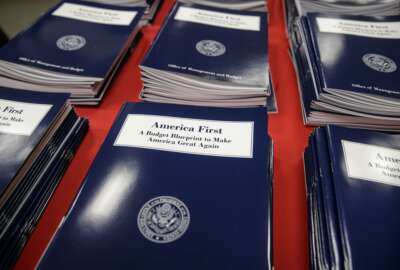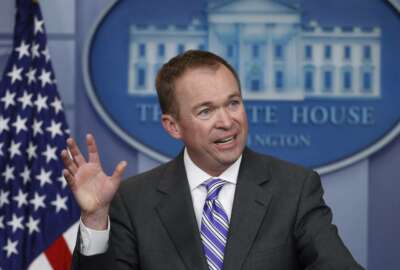
2018 budget highlights: A breakdown of what civilian agency programs are up, down
Most of the civilian agencies are taking some cuts in their budgets, and a number of programs are being eliminated.
Agriculture
Current levels: $22.6 billion
Proposed budget: $17.9 billion
Percent change: ⇓20.7%
- The budget plan calls for $6.2 billion in funding for the Special Supplemental Nutrition Program for Women, Infants and Children (WIC), which is $150 million less than the estimated $6.35 billion USDA budgeted in fiscal 2016.
- The budget plan reduces National Forest System funding for programs such as major new federal land acquisition. Instead, the budget focuses on maintaining existing forests and grasslands.
Commerce
Current levels: $9.2 billion
Proposed budget: $7.8 billion
Percent change: ⇓15.7%
- The budget plan provides $1.5 billion to the Census Bureau in order to prepare for the upcoming 2020 Census, an increase of more than $100 million. The funds will prioritize new IT advances for the Census count. GAO recently added the 2020 Census to its list of high-risk agencies and programs.
- The budget plan eliminates $250 million in targeted National Oceanic and Atmospheric Administration grants and programs that support coastal and marine management.
Education
Current levels: $68.2 billion
Proposed budget: $59.0 billion
Percent change: ⇓13.5%
- The budget plan calls for a $168 million increase in funding for charter schools, $250 million for a new private school choice program, and a $1 billion increase for Title I, which funds public school choice programs
Energy
Current levels: $29.7 billion
Proposed budget: $28.0 billion
Percent change: ⇓5.6%
- The proposed budget would decrease funding for the Office of Science by $900 million.
- The budget plan would decrease the Offices of Energy Efficiency and Renewable Energy, Nuclear Energy, and Electricity Delivery and Energy Reliability, along with other programs, by a total of $2 billion.
Environmental Protection Agency
Current levels: $8.2 billion
Proposed budget: $5.7 billion
Percent change: ⇓31%
- The proposed budget would eliminate 3,200 positions at the EPA.
- The budget plan attempts to reduce duplicative efforts by concentrating on EPA duties not also delegated to states. As such, it reduces funding for the Office of Enforcement and Compliance Assurance to $419 million, a $129 million drop.
- The Office of Research and Development would receive $250 million, down by $233 million from 2017.
Health and Human Services
Current levels: $77.7 billion
Proposed budget: $69.0 billion
Percent change: ⇓17.9%
- The proposed budget would increase funding to the Health Care Fraud and Abuse Control by $70 million, bringing it up to $751 million, in order to improve attempts to eliminate and prevent fraudulent or improper payments.
- The proposed budget would cut spending on the National Institutes of Health by $5.8 billion, leaving it with a total budget of $25.9 billion.
- It includes a reorganization of NIH that would eliminate the Fogarty International Center, consolidate the Agency for Healthcare Research and Quality, and make other structural changes and consolidations within NIH.
Homeland Security Department
Current levels: $41.3 billion
Proposed budget: $44.1 billion
Percent change: ⇑6.8%
- DHS would have more funding for border security and improving the immigration system.
- The White House is asking for $1.5 billion for federal cybersecurity, $15 million to begin the nationwide implementation of the E-Verify system that lets employers determine the eligibility of new employees.
- The proposal also would allocate $314 million to recruit, hire and train 500 new Border Patrol Agents and 1,000 new Immigration and Customs Enforcement law enforcement personnel in 2018.
Housing and Urban Development
Current levels: $46.9 billion
Proposed budget: $40.7 billion
Percent change: ⇓13.2%
- The proposed budget would eliminate the Community Development Block Grant Program, the HOME Investment Partnerships Program, Choice Neighborhoods and the Self-help Homeownership Opportunity Program.
Interior
Current levels: $13.2 billion
Proposed budget: $11.6 billion
Percent change: ⇓12%
- The proposed budget would cut land acquisition funding by more than $120 million, refocusing on deferred maintenance programs at the National Park Service.
- Other DoI construction and maintenance programs “can rely on existing resources for 2018,” the blueprint said.
- The budget plan would provide $900 million to the U.S. Geological Survey for research and data collection that informs sustainable energy development, responsible resource management and natural hazard risk reduction.
Justice Department
Current levels: $28.8 billion
Proposed budget: $27.7 billion
Percent change: ⇓3.8%
- The 3.8 percent decrease would be felt in programs the Trump administration believes are unnecessary and outdated, such as the State Criminal Alien Assistance Program.
- The White House proposes increases for Justice to hire 20 additional attorneys to pursue federal efforts to obtain the land and holdings necessary to secure the Southwest border and another 20 attorneys and support staff for immigration litigation assistance.
- Justice also could see an almost $80 million increase to hire 75 additional immigration judge teams, bringing the total number of funded immigration judge teams to 449.
Labor Department
Current levels: $12.2 billion
Proposed budget: $9.6 billion
Percent change: ⇓20.7%
- In the $9.6 billion discretionary proposal, the administration wants to expand the Reemployment and Eligibility Assessments, which is an evidence-based activity that saves an average of $536 per claimant in unemployment insurance benefit costs by reducing improper payments and getting claimants back to work more quickly and at higher wages.
- The White House also wants to reduce or eliminate funding for several programs, including the Senior Community Service Employment Program, Bureau of International Labor Affairs grant program and the Occupational Safety and Health Administration’s training grants initiative.
NASA
Current levels: $19.2 billion
Proposed budget: $19.1 billion
Percent change: ⇓0.8%
- The administration says it wants to reinvigorate the agency’s robotic exploration of the Solar System initiative by providing $1.9 billion for the Planetary Science program, including funding for a mission to repeatedly fly by Jupiter’s icy ocean moon Europa and a Mars rover that would launch in 2020.
- The proposal also would restructure “a duplicative robotic satellite refueling demonstration mission to reduce its cost and better position it to support a nascent commercial satellite servicing industry, resulting in a savings of $88 million from the 2017.”
- The White House also wants to expand public-private partnerships and build new opportunities for collaboration on space station operations, deep space habitation and exploration systems.
- The proposal offered no details, but emphasized it would strengthen NASA’s cybersecurity capabilities, safeguarding critical systems and data.
Small Business Administration
Current levels: $900 million
Proposed budget: $800 million
Percent change: ⇓5%
- The programs on the chopping block include the elimination of the PRIME technical assistance grants, Regional Innovation Clusters, and Growth Accelerators.
- The $43 million goes in part to supporting $45 billion in loan guarantees for small business owners, and also $1 billion in disaster relief funds. During her confirmation hearing, SBA Administrator Linda McMahon said one of her focuses would be on disaster relief programs, because when “small businesses are put out of business for a while, our economy suffers.”
Social Security Administration
Current levels: $9.3 billion
Proposed budget: $9.3 billion
Percent change: ⇑0.2%
- What the administration wants the agency to do with the boost is not clear from the budget plan.
- Earlier this month, Federal News Radio exclusively reported that SSA might have to furlough its workforce five days for every 1 percent cut to its administrative budget, according to a American Federation of Government Employees Council 220.
State Department, USAID, foreign aid
Current levels: $38.0 billion
Proposed budget: $27.1 billion
Percent change: ↓28%
- The request does include $12 billion in Overseas Contingency Operations (OCO) for “extraordinary costs.”
- The cuts will impact funding for foreign aids “whose missions do not substantially advance U.S. foreign policy interests, are duplicative, or are not well-managed.”
- Among the programs losing some or all of their money are the Global Climate Change Initiative; funding for UN peacekeeping ; the Emergency Refugee and Migration Assistance account; and funding for the Department of State’s Educational and Cultural Exchange (ECE) Programs.
Transportation Department
Current levels: $18.6 billion
Proposed budget: $16.2 billion
Percent change: ⇓12.7
- Included in the spending plan is a shift of air traffic control operations to a non-governmental organization, and cuts down on federal subsidies to Amtrak so that the train company can focus on its state-supported and northeast corridor services.
- The Federal Transit Administration’s Capital Investment Program (New Starts) will see its funding drop under the proposed budget.
- “Future investments in new transit projects would be funded by the localities that use and benefit from these localized projects,” the budget document stated.
Treasury Department
Current levels: $11.7 billion
Proposed budget: $11.2 billion
Percent change: ⇓4.4%
- The White House says the reductions would come from the IRS in the form of $239 million in savings from no longer relying on “antiquated operations that are still reliant on paper-based review in the era of electronic tax filing.”
- Treasury also would find savings by shrinking its workforce and increasing its efficiency “by redirecting resources away from duplicative policy offices to staff that manage the nation’s finances.”
- The proposal also strengthens cybersecurity by investing in a plan to enhance the security of existing systems and “existing security systems and preempt fragmentation of information technology management across the bureaus, positioning Treasury to anticipate and nimbly respond in the event of a cyberattack.”
Veterans Affairs
Current levels: $74.5 billion
Proposed budget: $78.9 billion
Percent change: ⇑5.9
- “An estimated 11 million veterans participate in VA programs,” the budget request stated. “This budget provides the resources necessary to ensure veterans receive the care and support earned through their service to the nation.”
- The money would go toward providing primary and specialized care, along with social support services, to veterans. VA health care made the Government Accountability Office’s biennial High-Risk List for the second time in 2017.
- Programs to help homeless and at-risk veterans also stands to gain from the budget request, and some money will go toward IT investments for the department.
The White House did not provide any budget breakdown information for the General Services Administration, the Army Corps of Engineers, the Nuclear Regulatory Commission, National Archives and Records Administration or the Office of Personnel Management.
Copyright © 2025 Federal News Network. All rights reserved. This website is not intended for users located within the European Economic Area.




